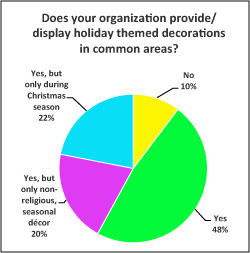In yesterday’s Advisor, we looked at some of the results of BLR’s 2015–2016 Holiday Survey. Today we’ll look at the rest of those results.
Deck the Halls
If their holiday decorations were within reason, 69.9% of survey participants allowed employees to display them. Another 20.4% allowed employees to display whatever they wanted. Display of nonreligious decorations was allowed by 5.7%, and 1.9% forbad employees from holiday decorating.
Along those same lines, 47.6% provided/displayed holiday themed decorations in common areas at their facility, 21.9% did so only during Christmas, and 20.1% displayed only nonreligious seasonal decor. No company-sponsored decorations were displayed by 10.3%.
 |
At 72.2%, almost three-fourths of survey participants hosted year-end or holiday parties for their employees, with 56% going off-site and 44% keeping the festivities in-house. Though 79.9% indicated they had never encountered issues such as employees’ drunk driving or inappropriate behavior, only 45.5% allowed alcoholic beverages at their holiday celebrations. For those who allowed alcohol at their holiday or year-end party, 37.5% provided rides home after the party.
When it came to who got invited to the party, 35.9% invite employees’ spouses and/or significant others to attend the celebration and 54.6% invited employees only.
Sharing
 |
Though 10% (same as 2014) had not yet decided about 2015, charitable activities were sponsored by or participated in for 64.4%. The types of activities were varied, with sponsoring a food drive topping the list and volunteer work or visits by employees during working hours trailing at the end of the list.
- Food drive, 57. 5%
- Toy drive, 57%
- Angel tree and/or adopt a family, 49.3%
- Clothing drive, 32%
- Monetary donation collected from employees, 31.8%
- Monetary donation from company, 31%
- Volunteer work or visits by employees during working hours, 22.2%
Is your employee handbook compliant? Find out on Friday, February 5, 2016, with a new interactive webinar—Employee Handbooks: Key Updates, Drafting Tips, and Enforcement Advice for 2016. Learn More
Survey Participants
A total of 1,053 individuals participated in this survey, which was conducted in September 2015. Of those who identified themselves, 61.7% represented private, for- profit organizations; 20% represented private, nonprofit; 7.5% were public sector; and 10.8% worked for government.
The majority (61.4%) of our survey respondents provided HR services to a workforce of 1–250 employees. Another 13.8% provided guidance to 251–500 employees at their organizations, and 8.4% have a workforce of 501–1,000 employees. Companies with 1,001–5,000 employees accounted for 9.8% of survey participants, and organizations with more than 5,000 employees comprise 6.6% of survey participants.
Over half (61.3%) of the participants were in service industries; 26.3% were in agriculture, forestry, construction, manufacturing, or mining; 8.4% were in wholesale, retail, transportation, or warehousing; and 4% were in real estate or utilities.
Manager level was represented by 40.5% of the survey participants; director level was represented by 25.8%, and by VP or higher accounts for 13.4%. Supervisors were represented by 4.2%, and staff level accounted for 16.1% of survey participants who self-identified.
Issues like what your expectations for your employees during the holidays are a great example of how your employee handbook serves the company and your employees—if it’s thorough and clearly communicate those expectations.
Your employee handbook can either be a legally sound document that helps you protect yourself while making your policies clear—or a legal nightmare filled with unintentional compliance issues. How can you be sure that your handbook falls within the law while also keeping your employees productive? Fortunately there’s timely help in the form of BLR’s new webinar—Employee Handbooks: Key Updates, Drafting Tips, and Enforcement Advice for 2016. In just 90 minutes, on Friday, February 5, you’ll learn everything you need to know about keeping your employee hand book compliant and up to date.
Register today for this interactive webinar.
Want to make sure that your employee handbook works? Join us Friday, February 5, 2016, for a new interactive webinar, Employee Handbooks: Key Updates, Drafting Tips, and Enforcement Advice for 2016. Earn 1.5 hours in HRCI Recertification Credit and 1.5 hours in SHRM Professional Development Credit. Register Now
By participating in this interactive webinar, you’ll learn:
- 2016 handbook components and policies you MUST include and some you may consider
- Changes in federal laws and regulations that drive employee handbook updates
- Dress code and grooming policy updates you should make
- Social media privacy and usage policies in light of NLRB scrutiny and agency guidance
- The difference between flexible and absolute language in the employee handbook
- BYOD (bring your own device) policies covering cell phone and tablet usage
- Your obligation to make personnel records available for inspection and how to update your handbook
- How long you should keep the old version of your employee handbook
- Tips for communicating handbook changes
- And much more!
Register now for this event risk-free.
Friday, February 5, 2016
1:30 p.m. to 3:00 p.m. (Eastern)
12:30 p.m. to 2:00 p.m. (Central)
11:30 a.m. to 1:00 p.m. (Mountain)
10:30 a.m. to 12:00 p.m. (Pacific)
Approved for Recertification Credit and Professional Development Credit
This program has been approved for 1.5 credit hours toward recertification through the Human Resource Certification Institute (HRCI) and 1.5 credit hours towards SHRM-CPSM or SHRM-SCPSM.
Join us on Friday, February 5, 2016—you’ll get the in-depth Employee Handbooks: Key Updates, Drafting Tips, and Enforcement Advice for 2016 webinar AND you’ll get all of your particular questions answered by our experts.
Train Your Entire Staff
As with all BLR®/HR Hero® webinars:
- Train all the staff you can fit around a conference phone.
- Get your (and their) specific phoned-in or e-mailed questions answered in Q&A sessions that follow the presentation.
